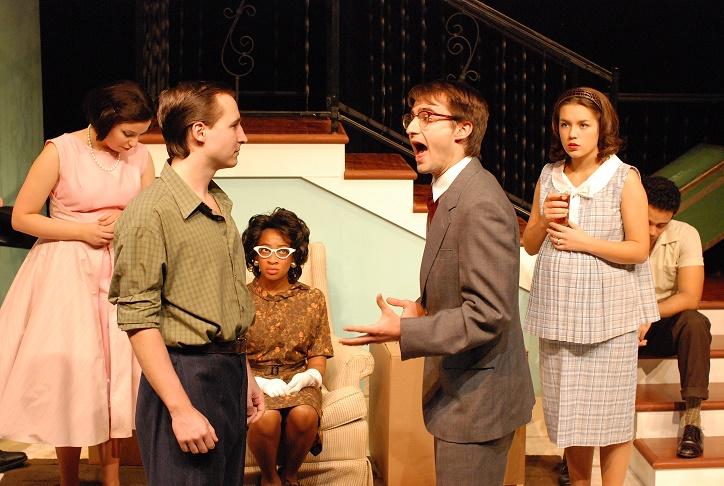By Sam Haas, city editor
His fist raised, the man advanced toward the minister. Before the man could knock him out, the preacher tripped backward over a pile of boxes and fell to the ground. The room exploded into a cacophony of anger, threats, confusion and racist overtones.
The Northeastern University Theatre Department’s production of “Clybourne Park” opened on Nov. 11. The satirical drama, written by Bruce Norris, presents two different stories focused on race, social dynamics, suffering and gentrification in a Chicago neighborhood separated by half a century.
“I’ve wanted to do a play that addresses the state of racial injustice and economic injustice in this country,” Jonathan Carr, director and a theater professor at Northeastern, said. “We have a different kind of conversation about race with people in a homogenous room than we do in a heterogeneous one.”
The first act, set in 1959, opens on a white family preparing to move out of their home in an all-white community after selling it to a black family.
In the second act, 50 years later, homeowners argue about the history and value of their gentrifying neighborhood. As the scenes develop, people struggle to talk about and consider each other’s experiences. Race plays a central role in their conflicts.
Every actor plays a different character in the second act than in the first, but themes, meaning and even lines of dialogue remain similar. Those echoes remind the audience that, while circumstances have changed considerably in 50 years, people across America still struggle with the effects of racism and segregation, according to Grant Terzakis, a senior theatre major acting in the play.
“In act two, we see these characters struggle to talk about race,” Terzakis said. “It’s a metaphor for the US as a whole; we can’t just pretend racism is over.”
Set design choices – one of the few technical elements of a mostly character-driven play – accentuate the connection between the acts, according to stage manager Jessica Halem, a junior theater and media and screen studies combined major.
“There’s a big wall piece in the set that’s frayed… In the first act that’s more metaphorical, speaking to the things that have happened in this house and the idea of this broken family.”
Dark humor and power dynamics play a role in facilitating the play’s message. The audience’s reaction to those jokes – and subsequent thoughts about what the appropriate reaction should have been – is one of the play’s most powerful features, according to Carr.
“The people in the room have to negotiate how to respond to a joke that might make them laugh,” Carr said. “Maybe it will make them laugh in private but not in public, or maybe they’ll laugh at it anyway and immediately feel terrible. How do they negotiate that?”
Humor and offensiveness are used to display a sense of white privilege in the play.
“There were truly horrifying jokes about women and truly awful jokes about black people,” Carr said. “None of them seemed to skewer a white person in the same way.”
While Carr hopes the play’s actors are successful in bringing humor to a controversial subject, his primary focus is convincing the audience to consider the subject itself.
“What I hope, at the end of the day, is we’re learning something about seeing each other for how we’d like to be seen [and] waking up to who’s around us, to who is empowered and who is not, to the way we create a welcoming space and to the way we live our lives,” Carr said.
Photo by Becca A. Lewis, courtesy Darren Evans















